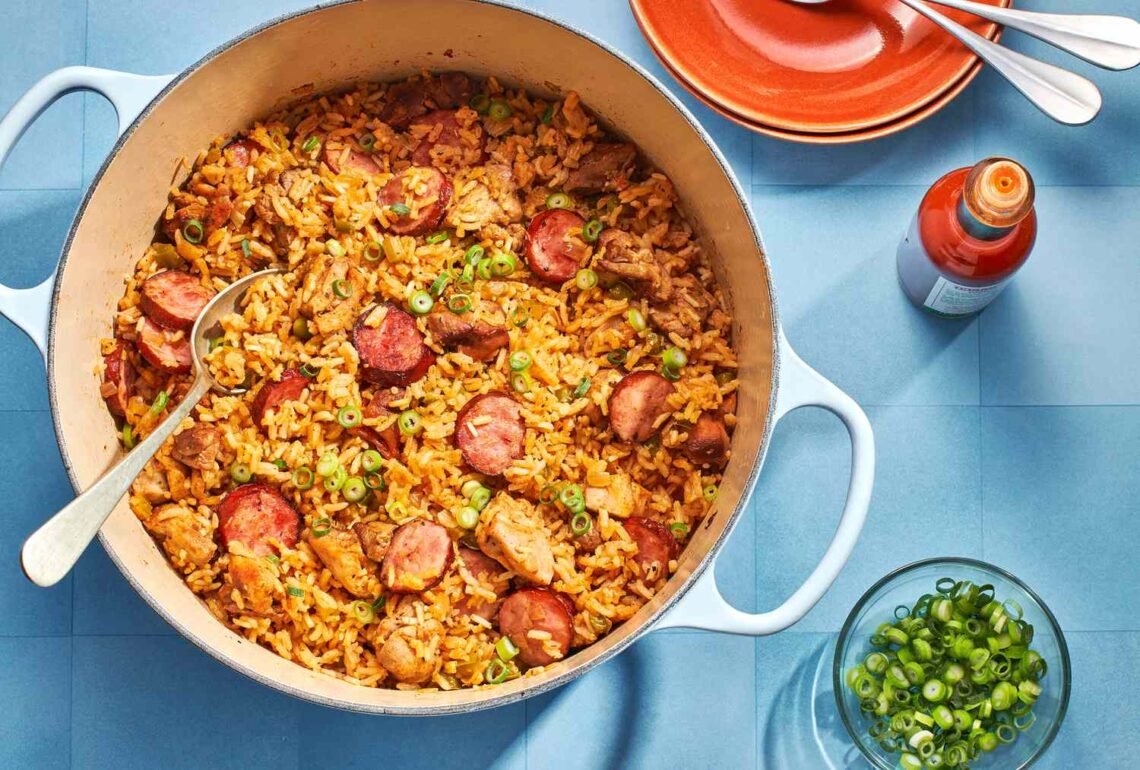
Presentation
Jambalaya is an exemplary dish that started in Louisiana, consolidating components of West African, French, and Spanish cooking styles. It’s a one-pot wonder loaded up with strong flavors and good fixings like rice, meats, and vegetables. Whether you’re a carefully prepared cook or a kitchen fledgling, creating Jambalaya can be both pleasant and fulfilling. This article will direct you through the most common way of making this tasty dish in the least demanding manner conceivable, guaranteeing that even amateurs can accomplish scrumptious outcomes.
What is Jambalaya?
Jambalaya is a famous dish in Creole and Cajun cooking, known for its flexibility and rich flavors. It normally incorporates a blend of meats (like wiener, chicken, and fish), vegetables (like ringer peppers, onions, and celery), and rice. The dish is prepared with a blend of flavors, including paprika, thyme, and cayenne pepper, giving it a particular and fulfilling taste.
There are two fundamental sorts of Jambalaya:
Creole Jambalaya (Red Jambalaya): This rendition incorporates tomatoes, giving the dish a rosy tint.
Cajun Jambalaya (Earthy colored Jambalaya): This rendition precludes tomatoes and depends on the cooking of the meat to foster its rich flavor.
Fundamental Elements for Jambalaya
To make Jambalaya, you’ll require the accompanying fundamental fixings:
Meat: Normal decisions incorporate andouille frankfurter, chicken, and shrimp. In any case, you can likewise utilize ham, pork, or even gator on the off chance that you’re feeling audacious.
Vegetables: The “Blessed Trinity” of Cajun cooking — onions, chime peppers, and celery — are fundamental. Garlic and tomatoes (for Creole Jambalaya) are likewise commonly included.
Rice: Long-grain white rice is the most generally utilized, yet you can likewise utilize earthy colored rice or different assortments assuming you like.
Flavors: A mix of flavors including paprika, thyme, oregano, cayenne pepper, dark pepper, and cove leaves. Cajun or Creole flavoring can likewise be utilized to improve on the cycle.
Fluid: Chicken stock or stock is regularly used to cook the rice and mix the dish with flavor.
Instruments and Gear Required
Before you begin cooking, ensure you have the accompanying instruments available:
Enormous Dutch Broiler or Weighty Lined Pot: This is fundamental for cooking Jambalaya uniformly and forestalling consuming.
Sharp Blade and Cutting Board: For hacking the vegetables and meat.
Estimating Cups and Spoons: To precisely gauge your fixings.
Wooden Spoon or Spatula: For blending the fixings.
Spoon: For serving the Jambalaya.
Bit by bit Manual for Making Jambalaya
1. Planning of Fixings
Before you begin cooking, setting up the entirety of your ingredients is urgent:
Cleave the Vegetables: Dice the onions, ringer peppers, and celery into little, even pieces. Mince the garlic.
Set up the Meat: If utilizing wiener, cut it into adjusts. Cut the chicken into scaled down pieces. In the case of utilizing shrimp, clean and devein them.
Measure the Flavors: Consolidate every one of your flavors in a little bowl, so they’re fit to be added brilliantly.
2. Cooking the Meat
Begin by cooking the meat, which will frame the foundation of your Jambalaya’s flavor:
Brown the Hotdog: Intensity a huge Dutch stove over medium intensity. Add a tablespoon of oil and cook the hotdog until sautéed on all sides. Eliminate the hotdog and put it away.
Cook the Chicken: In similar pot, add the chicken pieces. Cook until carmelized on all sides. Eliminate the chicken and put it to the side with the wiener.
Sauté the Shrimp (Optional): On the off chance that you’re utilizing shrimp, cook them rearward in a similar pot, just until they become pink and twist up. Eliminate and save with different meats.
3. Sautéing the Vegetables
When the meats are cooked and saved, it’s chance to sauté the vegetables. The “Blessed Trinity” of Cajun cooking — onions, ringer peppers, and celery — structure the fragrant base of Jambalaya.
Sauté the Onions, Ringer Peppers, and Celery: In a similar pot, add a touch more oil if necessary. Add the onions, chime peppers, and celery, blending incidentally until they become delicate and clear. This ought to require around 5-7 minutes.
Add the Garlic: Add the minced garlic to the pot and sauté for another 1-2 minutes, until fragrant.
4. Building the Flavor Base
Now that your vegetables are sautéed, now is the ideal time to assemble the flavor base of your Jambalaya by integrating flavors, tomatoes (for Creole Jambalaya), and fluid.
Add the Flavors: Sprinkle your pre-arranged zest blend over the sautéed vegetables. Mix to cover the vegetables equitably with the flavors. This step guarantees the flavors discharge their full flavor.
Add the Tomatoes (for Creole Jambalaya): On the off chance that you’re making Creole Jambalaya, add a container of diced tomatoes to the pot. Mix to consolidate.
Deglaze the Pot: Pour in a sprinkle of chicken stock or stock to deglaze the pot, scraping up any sautéed bits adhered to the base. These pieces are loaded with flavor and will improve the dish.
5. Cooking the Rice
The rice is a critical part of Jambalaya, engrossing every one of the flavors from the meat, vegetables, and flavors.
Add the Rice: Empty the uncooked rice into the pot, blending to cover the grains in the zest and vegetable combination. This assists the rice with retaining the flavors equally.
Add the Fluid: Pour in the excess chicken stock or stock, it is completely lowered to guarantee that the rice. Mix everything together to join.
Return the Meats to the Pot: Add the seared wiener and chicken back into the pot. Assuming that you’re utilizing shrimp, hold off on adding them until some other time.
Add Cove Leaves: Drop in two or three narrows leaves, which will add an unpretentious profundity of flavor as the Jambalaya cooks.
6. Stewing the Jambalaya
Stewing is the way to impeccably cooked Jambalaya. This sluggish cooking process permits the rice to assimilate every one of the flavors from the meats, vegetables, and flavors.
Heat To the point of boiling: Increment the intensity to carry the combination to a delicate bubble.
Stew: When bubbling, decrease the intensity to low, cover the pot, and let the Jambalaya stew. Cook for around 20-25 minutes, or until the rice is delicate and has consumed a large portion of the fluid.
Mix Sporadically: To keep the rice from adhering to the lower part of the pot, give the Jambalaya a delicate mix each 5-10 minutes.
7. Adding the Shrimp
Assuming you’re utilizing shrimp, it’s critical to add them towards the finish of the cooking system to abstain from overcooking.
Add the Shrimp: When the rice is almost cooked, tenderly mix the shrimp into the Jambalaya. Cover the pot and cook for an extra 5-7 minutes, or until the shrimp are pink and cooked through.
8. Last Flavoring and Changes
Prior to serving your Jambalaya, taste it and make any last flavoring changes.
Season to Taste: Taste the Jambalaya and add salt, pepper, or extra flavors if necessary.
Eliminate the Inlet Leaves: Prior to serving, make sure to eliminate the straight leaves from the pot.
Serving the Jambalaya
Jambalaya is commonly served directly from the pot, making it an ideal dish for family get-togethers or easygoing meals.
Decorate (Discretionary): You can embellish your Jambalaya with cleaved green onions or parsley for a new touch.
Serve: Utilize an enormous spoon to scoop the Jambalaya into bowls or onto plates. Serve it hot, with a side of hard bread or cornbread to absorb the tasty sauce.
Ways to make the Best Jambalaya
The following are a couple of tips to assist you with making the best Jambalaya:
Utilize Quality Fixings: Since Jambalaya is a straightforward dish, the nature of your fixings will fundamentally influence the end-product. Utilize new vegetables, excellent meats, and great stock.
Try not to Rush the Cooking System: Carmelizing the meats and sautéing the vegetables appropriately is pivotal for fostering the profound, rich flavors that make Jambalaya so tasty.
Change the Intensity Level As you would prefer: In the event that you favor a milder Jambalaya, decrease how much cayenne pepper. For more intensity, you can add additional cayenne or even a sprinkle of hot sauce.
Allow the Jambalaya To rest: Subsequent to cooking, let the Jambalaya rest for 5-10 minutes prior to serving. This permits the flavors to merge together and the rice to wrap up engrossing any excess fluid.
Varieties of Jambalaya
Jambalaya is a flexible dish that can be redone in endless ways. The following are a couple of varieties you should attempt:
Veggie lover Jambalaya: Preclude the meat and utilize vegetable stock rather than chicken stock. Add additional vegetables like zucchini, mushrooms, and okra for a good, sans meat rendition.
Fish Jambalaya: Spotlight on fish by utilizing shrimp, crab, and crayfish. You can likewise add fish or scallops for additional assortment.
Hotdog and Chicken Jambalaya: In the event that you lean toward a meatier dish, you can get serious about the wiener and chicken, overlooking the shrimp by and large.
Zesty Jambalaya: For the individuals who love heat, add additional cayenne pepper, a couple of runs of hot sauce, or even cut jalapeños to the dish.
Putting away and Warming Jambalaya
Jambalaya is an incredible dish for extras, as the flavors keep on creating as it sits.
Putting away: Permit the Jambalaya to cool totally prior to moving it to a sealed shut compartment. It tends to be put away in the cooler for as long as 3 days.
Freezing: Jambalaya can likewise be frozen for as long as 90 days. To freeze, segment the cooled Jambalaya into cooler safe holders or sacks, leaving some space at the top for development.
Warming: To warm, place the Jambalaya in a pot over medium intensity, adding a sprinkle of water or stock in the event that it seems dry. Mix sporadically until warmed through. In the case of warming from frozen, permit the Jambalaya to defrost in the fridge short-term prior to warming.
End
Making Jambalaya at home doesn’t need to be confounded. With this bit by bit guide, you can make a tasty, fulfilling dish that is ideally suited for any event. Whether you’re cooking for a group or only for yourself, this simple strategy guarantees that your Jambalaya will turn out delectable without fail.
By following these basic advances, you can partake in the rich, consoling kinds of Jambalaya with negligible exertion. Try different things with various meats, vegetables, and flavors to make the dish your own, and feel free to make changes in light of your taste inclinations. Jambalaya is tied in with uniting individuals over great food, so take as much time as necessary, partake all the while, and enjoy each nibble of this exemplary Southern dish.






Comments by uzairchippa066@gmail.com